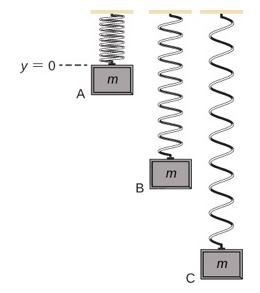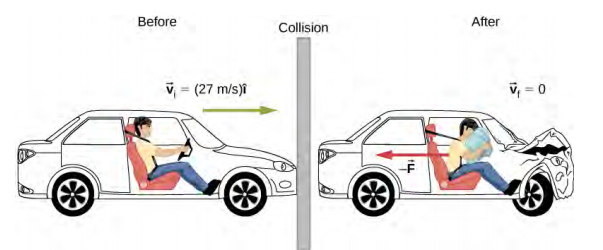Table of Contents
Questions and Problems
1. Non-conservative forces
You decide to move your couch to a new position on your horizontal living room floor. The normal force on the couch is $1$ kN and the coefficient of friction is $0.6$.
(A) You first push the couch 3 m parallel to a wall and then 1 m perpendicular to the wall ($A$ to $B$ in the figure). How much work is done by the frictional force $f$?
(B) You don’t like the new position, so you move the couch straight back to its original position ($B$ to $A$ in the figure). What was the total work done against friction moving the couch away from its original position and back again? What does it tell you about the work done by a non-conservative forces like friction?

Follow Example 7.2.2.
2. Conservative forces
(A) You lift an oversized library book, weighing $20$ N, $1$ m vertically down from a shelf, and carry it $3$ m horizontally to a table (shown below). How much work does gravity do on the book?
(B) When you’re finished, you move the book in a straight line back to its original place on the shelf. What was the total work done against gravity, moving the book away from its original position on the shelf and back again? What does it tell you about the nature of conservative forces like gravity.

Follow Example 7.2.3.
3. Work from force
An object moves along a parabolic path $y = 0.5 x^2$ from the origin $A = (0, 0)$ to the point $B = (2, 2)$ under the action of a force $\overrightarrow{F} = 5y \hat{i} + 10x \hat{j} (figure below). Calculate the work done.

Follow Example 7.2.4.
4. Work done by spring
(A) Derive an expression for calculating the work done by a spring.
(B) A perfectly elastic spring requires $0.54$ J of work to stretch $6$ cm from its equilibrium position, as in the figure (b) below. What is its spring constant $k$? And how much work is required to stretch it an additional $6$ cm?

Follow Example 7.2.5.
5. Bullets and boards
(A) Derive an expression for the work energy theorem. What is the meaning of the theorem?
(B) A bullet has a mass of $2.60$ g and a muzzle velocity of $1100$ ft./s ($335$ m/s). It can penetrate eight 1-inch pine boards, each with thickness $0.75$ inches. What is the average stopping force exerted by the wood, as shown in the figure below?

Follow Example 7.4.2.
6. Manpower
An $80$-kg army trainee does pull-ups on a horizontal bar (figure below). It takes the trainee $0.8$ seconds to raise the body from a lower position to where the chin is above the bar. How much power do the trainee’s muscles supply moving his body from the lower position to where the chin is above the bar? (Hint: Make reasonable estimates for any quantities needed.)

Follow Example 7.5.1.
7. Potential energy
A particle moves along the $x$-axis under the action of a force given by $F = -ax^2$, where the coefficient $a = 3$ N/m$^2$.
(A) What is the difference in its potential energy as it moves from $x_A = 1$ m to $x_B = 2$ m?
(B) What is the particle’s potential energy at $x = 1$ m with respect to a given $0.5$ J of potential energy at $x=0$?
Follow Example 8.2.1.
8. Gravitational and elastic
A block weighing $1.2$ N is hung from a spring with a spring constant of $6.0$ N/m, as shown in the figure below.
(A) What is the maximum expansion of the spring, as seen at point C?
(B) What is the total potential energy at point B, halfway between A and C?
(C) What is the speed of the block at point B?

Follow Example 8.2.4.
9. Simple pendulum
A particle of mass $m$ is hung from the ceiling by a massless string of length $1.0$ m, as shown in the figure below. The particle is released from rest, when the angle between the string and the downward vertical direction is $30^\circ$. What is its speed when it reaches the lowest point of its arc?

Follow Example 8.7.

10. Car crash
A car traveling at $27$ m/s collides with a building. The collision with the building causes the car to come to a stop in approximately $1$ second. The driver, who weighs $860$ N, is protected by a combination of a variable-tension seatbelt and an airbag (figure below). (In effect, the driver collides with the seatbelt and airbag and not with the building.) The airbag and seatbelt slow his velocity, such that he comes to a stop in approximately $2.5$ s.
(A) What average force does the driver experience during the collision?
(B) Without the seatbelt and airbag, his collision time (with the steering wheel) would have been approximately $0.20$ s. What force would he experience in this case? What is the difference between the forces in (A) and (B)?

Follow Example 9.3.2.
11. The iPhone drop
Apple released its iPhone 6 Plus in November 2014. According to many reports, it was originally supposed to have a screen made from sapphire, but that was changed at the last minute for a hardened glass screen. Reportedly, this was because the sapphire screen cracked when the phone was dropped. What force did the iPhone 6 Plus experience as a result of being dropped?

Follow Example 9.4.2.
12. Tennis serve
During the 2007 French Open, Venus Williams hit the fastest recorded serve in a premier women’s match, reaching a speed of $58$ m/s. What is the average force exerted on the 0.057-kg tennis ball by Venus Williams’ racquet? Assume that the ball’s speed just after impact is 58 m/s, as shown in the figure, that the initial horizontal component of the velocity before impact is negligible, and that the ball remained in contact with the racquet for $5.0$ ms.

Follow Example 9.4.3.
13. Colliding carts
Two carts in a physics lab roll on a level track, with negligible friction. These carts have small magnets at their ends, so that when they collide, they stick together (figure below). The first cart has a mass of $675$ grams and is rolling at $0.75$ m/s to the right; the second has a mass of $500$ grams and is rolling at $1.33$ m/s, also to the right. After the collision, what is the velocity of the two joined carts?

Follow Example 9.6.1.
